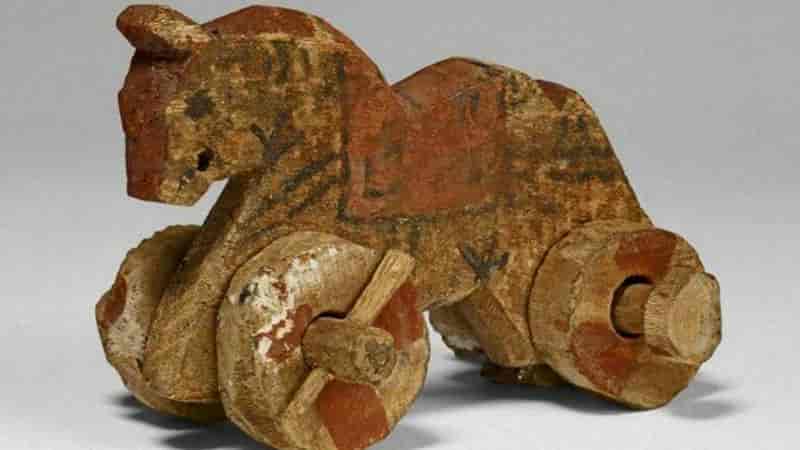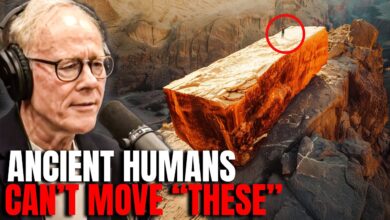These Ancient Relics Are So Advanced They Really Shouldn’t Exist
**1. Salzburg Cube (Wolfsegg Iron)**

The Salzburg Cube, also known as the “Wolfsegg Iron,” was found in Austria in a 20-million-year-old coal mine. It is a block of iron with flat and convex sides and a cut from top to bottom, making it appear to have been shaped by humans. It was initially thought to be a meteorite, but this theory was dismissed. Some have suggested that it was machine-made, but there is no evidence to support this. The cube has since disappeared from museums, leaving only a cast for study. Its origin and purpose remain a mystery.
—
**2. Ancient Egyptian Toy**

An ancient Egyptian toy that was intricately designed with a gear mechanism that moves when wound. This shows that the ancient Egyptians were not only focused on rituals or construction, but also created complex entertainment items, demonstrating their advanced technical skills.
—
**3. London Hammer**
The hammer was discovered in 1936 in London, Texas, when a block of stone encasing a piece of wood and a hammerhead emerged. Although some people claimed it was proof of evolution, analysis showed that it was a 19th-century hammer, stuck in the rock due to rapid geological processes. The artifact, while strange, is not evidence of time travel or ancient civilization.
—
**4. “Alien Antenna” from the Almirante**
In 1964, an American research ship took pictures of the seabed of South Africa, where an “antenna”-like object was found at a depth of 4,000m. Initially, many thought it was an alien device. However, scientists confirmed it was a rare carnivorous sponge, clearing up a decades-long misunderstanding.
—
**5. Nazca Lines**

The Nazca Lines in Peru are more than 100 giant drawings in the desert, depicting animals, people, and abstract shapes. The ancient Nazca people created the lines by digging up the ground to reveal the lighter sand underneath. How they made the precise designs without looking from above is still a mystery. Their purpose may have been related to religion or astronomy.
—
**6. Atacama Skeleton**

A small, misshapen skeleton found in the Atacama Desert, Chile, was initially mistaken for an alien. After genetic analysis, it was confirmed to be the skeleton of a fetus with a severe genetic mutation, resulting in an unusual appearance.
—
**7. Viking Penny**

An 11th-century Olaf Kyrre coin found in Maine, USA, has raised questions about the presence of Vikings in the area. Although it may have been brought by someone else, the artifact suggests potential links between distant civilizations.
—
**8. Baghdad Battery**

The Baghdad Battery, consisting of a ceramic pot, copper tube and iron bar, is believed to date from 200 AD. It can generate a small electric current, leading to speculation that the ancients used it for electroplating or medicine. However, the artifact went missing during the Iraq War, stalling further research.
—
**9. Antikythera Mechanism**

Found off the coast of Greece, this mechanism is considered the world’s oldest “mechanical computer”, used to calculate astronomical phenomena such as eclipses and the positions of constellations. It was built in 100 BC, showing the incredible scientific level of the ancient Greeks.
**Voynich Manuscript**:

The Voynich Manuscript is one of the most mysterious documents in history, discovered in 1912 by Wilfrid Voynich, an antiquarian book dealer. It is written in an unknown language, with strange illustrations of plants, people, and diagrams that no one has been able to decipher. Despite the efforts of many experts and cryptographers, the contents of the manuscript remain a mystery, giving rise to theories of extraterrestrial origin or ancient encryption.
**Piri Reis Map**:

Drawn in 1513 by Ottoman admiral Piri Reis, this map is not only incredibly accurate for its time, but also contains puzzling details, such as the outline of the coasts of South America and Antarctica when those regions were still unexplored. Only a third of the map has been found, but it continues to be the subject of controversy, with some arguing that it reflects knowledge from a lost civilization.
**Delhi Iron Pillar**:

The 20-foot-tall iron pillar in Delhi, India, has stood for 1,600 years without rusting, despite harsh weather conditions. Research has shown that the pillar was made of 98 percent pure iron, a feat of technology far beyond the level of ancient metallurgy. Many theories surround the construction technique and religious significance of the structure.
**Damascus Steel**:

This ancient steel is known for its high strength and resistance to breakage, and was often used to forge swords. Damascus swords have distinctive patterns and are considered a symbol of advanced metalworking techniques. However, the recipe for making Damascus steel has been lost, making it impossible for modern scientists to perfectly recreate.
**Roman Concrete**:

The Romans developed a type of concrete that is incredibly durable, allowing structures like the Colosseum to last for thousands of years. This concrete combines volcanic ash with a “hot mix” technique, creating chemical reactions that allow it to heal itself when it cracks. A 2023 discovery suggests that this formula could be replicated to build more sustainable structures in the future.
**Roman Aqueducts**:

The Roman aqueduct system was an engineering marvel, transporting water from sources up to 59 miles (92km) to the city. Rome alone had 11 aqueducts, built over centuries, providing clean water to residents and public baths. Their durability and efficiency are still admired today.
**Chinese Earthquake Meter**:

Scientist Zhang Heng built a device to detect earthquakes more than 2,000 years ago. The device is in the form of a round jar, with dragons holding a ball in their mouths. When an earthquake occurs, the ball will fall, pointing in the direction of the epicenter. Although the operating principle is unknown, this design demonstrates the ancient Chinese wisdom beyond its time.
**Astrolabe**:

A widely used navigational device in ancient and medieval times, the astrolabe helps determine location based on the stars. It can also calculate time, geographical position and assist in solving math problems, and is considered a multi-purpose tool for sailors and astronomers.
**Shigir Statue**:

The Shigir Statue, discovered in Russia, is the world’s oldest wooden sculpture, dating back about 12,000 years. It is decorated with intricate motifs and a face at the top, but its purpose and meaning remain a mystery.
**Roman Monohedra**:

This 12-sided object, found in Belgium and believed to be around 1,600 years old, is puzzling because there is no documentation of its function. Only about 120 have been discovered, with their design and purpose unknown, leading to theories about their religious or astronomical uses.
**Klerksdorp Sphere**:

These small spheres were found in 3 billion-year-old sedimentary layers in South Africa. Some believe they are natural, but others believe they are man-made, raising big questions about evolution and human history.









